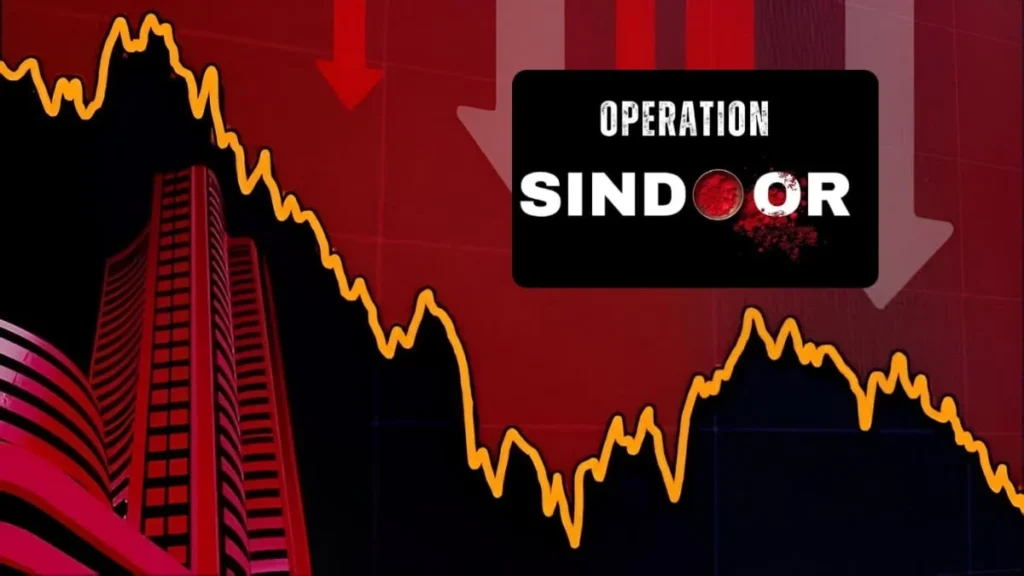
India rupee falls after Operation Sindoor — a military offensive intended to strike at the heart of terrorist camps in Pakistan has had an unexpected domestic consequence. On Wednesday, the Indian rupee saw a sharp decline of 45 paise, closing at ₹84.80 against the US dollar. This currency dip follows India’s precision strikes on nine key terror hideouts in Pakistan and Pakistan-occupied Kashmir (PoK), including locations linked to Jaish-e-Mohammed and Lashkar-e-Taiba.
While India delivered a strong geopolitical message, the economic repercussions were immediate and significant. Unlike the stock market, which absorbed the shock with minor gains, the currency market took a hit, revealing the hidden cost of military escalation.
Table of Contents
⚠️ Why Did the Indian Rupee Fall After Operation Sindoor?
The India rupee falls after Operation Sindoor largely due to investor caution and a surge in geopolitical risk. Military operations inherently bring uncertainty, and global markets tend to react quickly to such volatility. According to currency analysts, the 45 paise drop in one day is a direct reflection of how foreign investors perceived the rising risk in the subcontinent.
The rupee opened at 84.65, fluctuated between 84.47 and 84.93, and closed at 84.80. In contrast, the Pakistani rupee also declined but by a smaller margin — falling 13 paise to 281.30 against the dollar on the same day.
This contrast has puzzled many experts, especially since India’s economy is significantly larger and stronger. However, analysts believe the magnitude of investor exposure and higher market sensitivity in India contributes to sharper currency fluctuations.
🗨️ Expert Views on Rupee Movement Post-Operation
Currency expert Anuj Gupta, Head of Commodity & Currency at HDFC Securities, notes that Thursday might offer some respite for the rupee, particularly if global cues remain neutral and crude oil prices stabilize.
Similarly, Anuj Chaudhary, Research Analyst at Mirae Asset Sharekhan, says:
“The rupee may trade with a slightly positive bias due to a weaker dollar, improved risk sentiment, and FII inflows. However, geopolitical tensions and rising oil prices remain major downside risks.”
He expects the USD-INR spot rate to move between ₹84.40 and ₹85.10 in the coming sessions.
📊 Stock Market Responds Differently
Interestingly, the Indian stock markets showed resilience. Despite early volatility, both Sensex and Nifty managed to close in the green. The BSE Sensex ended 105.71 points higher at 80,746.78, and the Nifty climbed 34.80 points to finish at 24,414.40.
Foreign institutional investors (FIIs) also displayed confidence in the equity market. Data shows they bought shares worth ₹3,794.52 crore on a net basis on Tuesday, signaling a decoupling between currency and equity sentiments for the time being.
Read more: ‘ऑपरेशन सिंदूर’ के बाद भारत को यहां हुआ मोटा नुकसान, नहीं सोचा था ऐसा होगा
🔍 Comparing Currency Trends: INR vs PKR
The India rupee falls after Operation Sindoor, but what about its Pakistani counterpart?
While India’s INR dropped 45 paise on Wednesday, the Pakistani rupee slipped just 13 paise, closing at 281.30. Over two days, the total drop for INR is 50 paise, whereas the PKR fell only 45 paise. This narrower movement in PKR has surprised many, given Pakistan’s vulnerable economic condition.
However, experts caution against reading too much into short-term trends. The Indian rupee is far more liquid and actively traded, and hence more sensitive to global sentiment and large institutional flows.
🔮 What Lies Ahead for the Rupee?
With India rupee falls after Operation Sindoor making headlines, what can traders expect next?
- If tensions escalate, the rupee could weaken further toward the 85.10 mark or beyond.
- If calm is restored, a swift recovery might take place due to India’s sound economic fundamentals.
- Crude oil prices remain another wild card. A spike in Brent crude (now at $62.41 per barrel) could weigh further on the rupee.
- Global attention is also on the upcoming US FOMC meeting, where interest rates are expected to remain unchanged, potentially stabilizing the dollar.
📌 Conclusion
The India rupee falls after Operation Sindoor illustrates a vital lesson in geopolitics and finance: every military action has economic consequences. Even as India strengthens its security posture through targeted operations, the markets remain sensitive to any escalation.
For now, the situation is fluid. All eyes are on the next diplomatic or military move — and how it might ripple through the financial ecosystem. In this delicate dance between national security and economic stability, the Indian rupee has emerged as one of the earliest and most visible casualties.
Recent News
- Squid Game: The Global Phenomenon That Redefined Survival Drama
- Man City vs Al-Hilal: A Clash of Champions from Two Football Worlds
- Surat Dabba Trading Scam: ₹948 કરોડનું કૌભાંડ, 10 લોકોની ધરપકડથી ખળભળાટ
- Hundreds of Families Displaced by Israeli Air Strikes in Gaza
- Breaking News 🛑: સુરતમાં 4 કલાકમાં સાડા પાંચ ઈંચ વરસાદથી જળબંબાકાર, શાળાઓમાં રજાઓ કરાઇ જાહેર, Surat heavy rain 2025
- Gujarat CM OKays 3394 crore માટે મહત્ત્વના વિકાસ કાર્ય માટે મંજૂરી
- 🚜 સરકાર આપશે ટ્રેકટર ખરીદવા માટે સહાય, આવી રીતે જાતે કરો અરજી – Tractor Sahay Yojana 2025
Read More
- NDTV India is Hindi News Website. Read Hindi News, Latest Hindi News, Today Hindi News, Breaking Hindi News, Hindi Samachar
- Today’s news: Get latest and Breaking News on Politics, Business, Lifestyle, Entertainment and Sports along with News updates from around the world.
- Read the Latest News Updates online related to India, World and US business and economy.
- Times of India: News – Breaking News, Latest News, India.
- Stay updated with Sutra Samachar, your trusted source for the latest news, breaking headlines, and trending stories from India and around the world.
